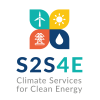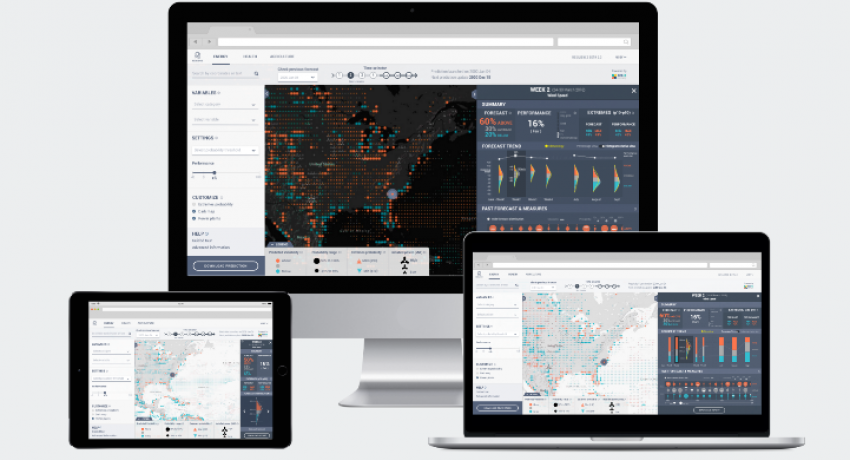With the completion of the project in December 2020, the S2S4E team wants to highlight some core aspects of the development of a climate service for energy: The S2S4E Decision Support Tool (DST).
Large-scale deployment of renewable energy sources is key for the clean energy transition, which is needed to comply with the greenhouse gas (GHG) emissions reduction agreed upon in the Paris Agreement and to achieve the European Green Deal ambition of reaching carbon neutrality by 2050. However, renewable energy generation and electricity demand are largely dependent on atmospheric conditions. The energy industry typically uses past climatology data to determine future conditions, which cannot help anticipate extreme events.
The EU–funded S2S4E project conducted research on S2S forecasts for the energy sector and developed an operational forecasting tool, the S2S4E Decision Support Tool (DST; www.s2s4e.eu/dst). This tool was co-designed with the energy industry to provide climate information to energy producers and providers for the next weeks and months on variables such as temperature, precipitation and solar radiation, helping them make better-informed decisions (Soret et al., 2019).
With the completion of the project in December 2020, we want to highlight some core aspects of the development of a climate service for energy within the project.
Co-development of a climate service for energy
Co-development has been a pillar of the project. A fruitful collaboration among research institutes, energy companies, small and medium-sized enterprises, and a consulting company allowed for creating an interdisciplinary team with a common goal.
Since the very beginning of the project, and building on previous experience, each partner has been actively involved in the creation process. Three energy companies represented the needs of the sector. Transforming sector needs into research lines and translating the outcomes into usable information for energy users is a complex but fundamental process. It entails not only the scientific development of forecasts for essential climate variables and indicators, but also everything that is related to the delivery and understanding of the information (operational workflow, forecast release timings, visualisations, products, etc.).
Implementation of a real-time operational forecast workflow
The operationalisation of the forecasts entailed both scientific and technical challenges. The DST has been providing subseasonal and seasonal forecasts in real-time until the project ended in December 2020. The subseasonal forecasts were updated every Thursday and provided information for the following four weeks.
An operational workflow was designed to download, post -process and deliver these forecasts, adapted to the schedule of the ECMWF-Ext-ENS prediction system (Vitart et al., 2008) provided by the S2S Real-Time Pilot Initiative. Hindcasts were also downloaded from the system, and served for forecast calibration and quality assessment using as a reference system ERA5 reanalysis (Hersbach et al. 2020). The details of the operational implementation are being included in an upcoming publication (Manrique-Suñén et al., 2021).
A fundamental step for the usability of climate predictions is to remove the drift. The methodology employed was the variance inflation (Doblas-Reyes et al., 2005), which also modifies the predictions to have the same interannual variance as the reference. The calibration was applied to each lead time and the climatological distribution of both prediction system and reference were calculated using a running window, to avoid misrepresentation of the climatology (Manrique-Suñén et al., 2020).
Probabilities of each tercile category (above normal, normal or below normal) and the probability of extremes (above p90 and below p10) were presented in the DST. Each forecast was provided with an associated skill score (per variable, grid point, initialisation and lead time) to guide the user in the interpretation of the forecast. Fair Ranked Probability Skill Scores were employed for the tercile categories and Fair Brier Skill Scores were shown for extremes (above p90 and below p10).
The workflow to process this information involved downloading and calibrating the available hindcast each Monday, and performing the skill calculation, which needed to be ready by Thursday. On Thursday, the real-time forecast was downloaded and calibrated, and the probabilities were computed from the 51 ensemble members and transferred to the DST for visualisation along with the skill information.
Improving user’s interaction with S2S forecasts
The development of the DST visual interface involved S2S4E experts from different disciplines (climate science, design, user-centered design, user interaction and cognitive psychology). Building on the user feedback obtained for a previous prototype (Project Ukko; Jiménez et al., 2018) and S2S4E research on user needs (e.g. Orlov et al., 2020), we developed a new tool with changes in the visual encoding of uncertainty and the use of interactive elements.
In general, changes in the shape and size (i.e. the visual encoding of the information) as well as the reduction of categories, enhanced the clarity and ease of use of the DST, reducing the feeling of effort when processing and dealing with climate information (Calvo et al., 2021).
The DST design also offered multiple interactive elements that allowed users to filter non-relevant information or highlight relevant information for the decision at hand. The application of user-centered design to these interactive elements reduced the cognitive load of users and thus improved user experience.
Beyond the DST, the project also co-developed with energy users other formats for the provision of S2S forecasts, such as PDF outlooks, temperature extremes outlooks published on social media, webinars or analyses of forecast performance through case studies of past events.
Testing operational forecasts with users
When the first operational version of the service was launched, the co-creation had still a long way to go. In fact, the operational testing phase provided constant information exchange, allowing for improving the service and supporting the integration of the forecasts in decision-making processes.
From one to one structured meetings with users to hands-on sessions and free access to the prototype, users within the project consortium and beyond actively interacted with the DST and the S2S4E team.
The service has been substantially improved based on the lessons learned, however further tailoring to user needs will be implemented in the commercialisation phase. The key findings about the development of climate services for energy are collected in an upcoming paper (Vigo et al., 2021), which also discusses the strengths and weaknesses of the co-development methodology adopted.
The process in these four core aspects of the project has not always been smooth. Different challenges arose that highlighted the importance of the demand side and the need to improve the co-creation dynamics from research to operations.
This article was originally published in the Subseasonal to Seasonal Prediction Project (S2S) newsletter No. 16 (March 2021). Written by Andrea Manrique-Suñén, Ilaria Vigo, Andria Nicodemou, Isadora Jiménez and Albert Soret (Barcelona Supercomputing Center).
References
• Calvo, L., Christel, I., Terrado, M. et al. (2021). Users cognitive load: A key aspect to successfully communicate visual climate information. BAMS (submitted, under second review)
• Christel, I., Hemment, D., Bojovic, D. et al., 2018: Introducing design in the development of effective climate services. Clim. Serv., 9, 111–121. https://doi.org/10.1016/j.cliser.2017.06.002
• Doblas-Reyes, F. J., Hagedorn, R., and Palmer, T. N. (2005). The rationale behind the success of multi-model ensembles in seasonal forecasting – II. Calibration and combination. Tellus A: Dynamic Meteorology and Oceanography, 57(3), 234–252. https://doi.org/10.3402/tellusa.v57i3.14658
• Hersbach, H., Bell, B., Berrisford, P. et al. (2020). The ERA5 Global Reanalysis. Quarterly Journal of the Royal Meteorological Society, qj.3803. https://doi.org/10.1002/qj.3803
• Manrique-Suñén, A., Gonzalez-Reviriego, N., Torralba, V. et al. (2020). Choices in the verification of S2S forecasts and their implications for climate services. Monthly Weather Review, 148(10), 3995–4008. https://doi.org/10.1175/MWR-D-20-0067.1
• Manrique-Suñén, A., Palma, Ll., Gonzalez-Reviriego, N. et al. (2021) Subseasonal predictions, a recipe for operational implementation (to be submitted).
• Orlov, A., Sillman, J., and Vigo, I. (2020). Better seasonal forecasts for the renewable energy industry. Nature Energy, 5, 108-110, doi:10.1038/s41560-020-0561-5
• Soret, A., Torralba, V., Cortesi, N. et al. (2019). Sub-seasonal to seasonal climate predictions for wind energy forecasting. Journal of Physics: Conference Series, 1222(1), 012009. https://doi.org/10.1088/1742-6596/1222/1/012009
• Vigo, I., Whittlesey, S., Manrique-Suñén, A., et al. (2021). Co-creating, delivering and integrating S2S climate services for energy (to be submitted)
• Vitart, F., Buizza, R., Alonso Balmaseda, M. et al (2008). The new VarEPS-monthly forecasting system: A first step towards seamless prediction. Quarterly Journal of the Royal Meteorological Society, 134(636), 1789–1799. https://doi.org/10.1002/qj.322


